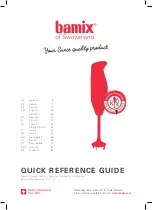
14
EURORACK MX3242X
These are designed to give a smooth logarithmic taper of a type more usually associated with megabuck
consoles. The performance, even at low levels, is far smoother than that of a normal budget fader.
The PANORAMA control
positions the output of the channel in the stereo field. Its constant-power design
ensures there are no level discrepancies whether a signal is hard-panned, center-stage, or somewhere
in-between. Such pin-point accuracy will be a revelation if you have been working on consoles with lower
quality circuits.
PFL/SOLO we encountered in section 2.1.1. SOLO also follows channel pan.
The MUTE button
is ergonomically placed immediately above the channel fader. Engaging MUTE is
equivalent to setting a fader level of minus infinity (Main Mix or Subgroup buses), and is indicated by a light-
emitting diode.
With the ROUTING buttons
you can route the Main input channel either to the Main Mix or one of the four
Subgroup buses. For example, if you want to route a signal to Subgroup 3 for recording, simply press routing
button 3-4 and turn the PANORAMA control fully to the left.
2.1.5 FLIP switch
For recording purposes you will want the Main input channel to process the input signals coming from a
microphone, direct-injection box or instrument, while the Mix-B input channel is used to monitor the tracks
already recorded. For mixdowns, on the other hand, it would be a great advantage if you had the Equalizer,
Aux buses, insert and routing options available via the Subgroups (e.g. to create a drum set sub-mix), so as to
process the recorded signals played back by the multi-track recorder. Now, you could re-connect the mono
and Mix-B input channels to be able to use the various processing options in the Main input channels for the
recorded tracks a method that is anything but straightforward! The EURORACK MX3242X features a FLIP
switch
(see fig. 2.3) which simply exchanges the signals of both channels. Thus, the Tape Return signal
is routed to the Main input channel, while the Mix-B input channel now carries audio signals, e.g. from MIDI and
effects equipment (which usually need less processing than the raw signals coming from a multi-track
recorder).
2.2 Mix-B input channel
The Mix-B input channels are independent secondary channels with their own set of PANORAMA
and
LEVEL
controls. Their output is permanently routed to the Mix-B bus. The sum of all signals from the
Mix-B channels can be taken from the MIX-B OUT jacks
located on the interface panel. Additionally, you
can route the Mix-B bus to the Main Mix bus. More on this in chapter 2.2.3 Routing. Each Mix-B channel has
a balanced line-level input on a ¼ phone jack
. The operating level (+4 dBu / -10 dBV) can be set globally
for all channels by pressing button
on the interface panel. In a recording situation you will want to use the
Mix-B input channels to return the tracks recorded on a multi-track machine. Here, the OPERATING LEVEL
switch helps you adapt the console to the recorder used.
2.2.1 Input level setting
Fig. 2.7: OPERATING LEVEL button for Mix-B input channels
The Mix-B channels on the MX3242X are specifically designed for typical line-level signals, in particular,
those from Tape Returns. The OPERATING LEVEL switch enables you to adapt the operating level of these
inputs (+4 dBu / -10 dBV) to the devices/instruments that are connected to them.
2.2.2 Aux Send buses
These are the same as for the main input channels (see 2.1.3). Please note, however, that the SOURCE
button of Aux Sends 1 and 2, or 3 through 6 must be pressed to make the respective Aux Sends available to
the Mix-B signal.
2. OPERATION















































